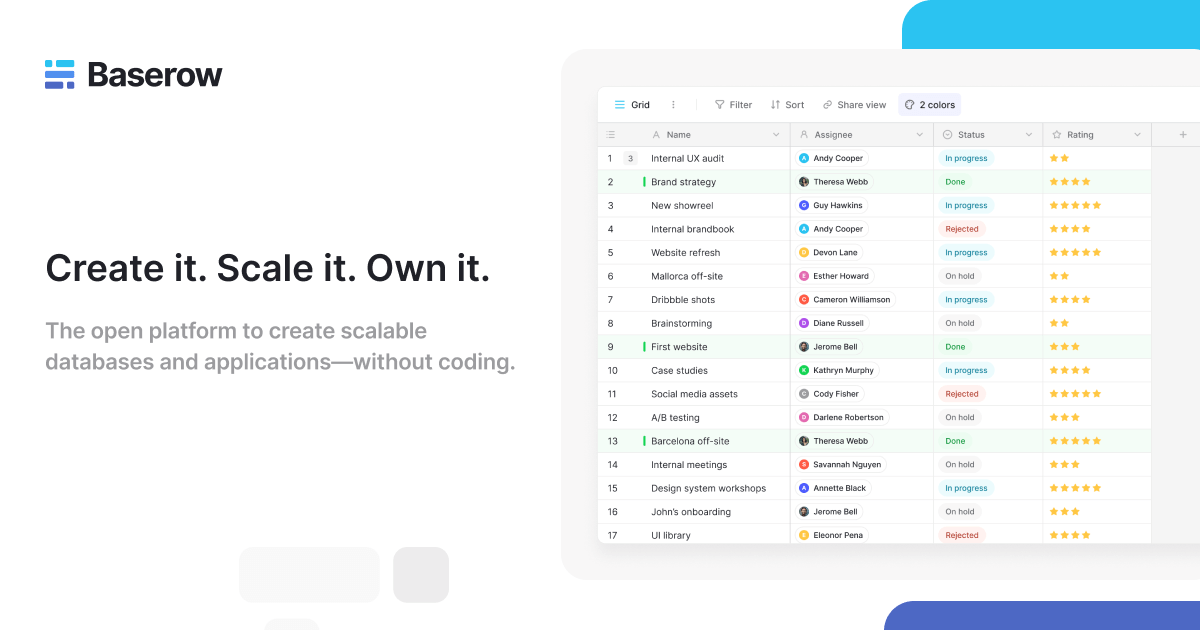Discover Exactly How Scalable Data Sources Can Be Utilized Without Coding to Improve Your Business Workflow
In today's fast-paced organization setting, the capability to handle and examine data effectively is paramount. Scalable data sources, particularly when paired with no-code services, offer a transformative technique that encourages non-technical customers to enhance procedures. By using devices that need no coding competence, companies can improve their functional abilities while minimizing reliance on IT resources. However, the actual question lies in recognizing just how these options can be customized to particular service demands and what potential obstacles may occur in their application. Checking out these facets can light up the path to operational excellence.
Understanding Scalable Databases
Scalable data sources are necessary for modern company operations, allowing organizations to effectively manage increasing quantities of data without compromising performance. These data sources are developed to adjust and grow to the altering demands of an organization, making certain that they can deal with bigger datasets and even more complex queries as business demands develop.
Understanding scalable data sources entails recognizing their 2 key kinds: vertical scaling and straight scaling. Upright scaling, or "scaling up," entails including more power (CPU, RAM) to an existing web server to boost efficiency. Alternatively, horizontal scaling, or "scaling out," requires including extra servers to distribute the lots, which frequently causes better adaptability and mistake resistance.
An additional critical facet is the style of scalable databases, which can be either non-relational or relational. Relational databases, such as MySQL and PostgreSQL, are structured and use SQL for questions, while non-relational data sources, like MongoDB and Cassandra, use more adaptability with disorganized information.
Eventually, understanding scalable data sources is important for companies intending to utilize data as a critical property, allowing them to remain competitive in a significantly data-driven atmosphere.
Advantages of No-Code Solutions
Opening the capacity of no-code services empowers services to streamline procedures and boost productivity without the requirement for substantial programming understanding. These systems permit non-technical customers to create, change, and handle data sources easily, hence equalizing accessibility to technology across groups.
One of the main benefits of no-code options is their rate of implementation. Companies can quickly release applications and automate procedures, significantly lowering the moment invested in development cycles. This dexterity makes it possible for organizations to respond promptly to market modifications and consumer demands, cultivating an one-upmanship.
Furthermore, no-code systems decrease reliance on IT divisions for day-to-day tasks, permitting technological teams to focus on more complicated tasks that call for specialized abilities. This shift not just optimizes source allowance but additionally promotes development within the company.
Cost-effectiveness is an additional advantage, as no-code services can reduce development and upkeep costs. By minimizing the demand for coding expertise, companies can harness the capabilities of their existing workforce without the expenses of working with added personnel.
Popular No-Code Data Source Equipment
The increase of no-code remedies has caused the development of numerous data source tools that deal with companies seeking efficiency and access. These tools empower users with restricted technological expertise to create, manage, and manipulate databases flawlessly.

Caspio sticks out for its capability to construct web applications with no coding. It enables services to produce robust data sources and deploy applications swiftly, satisfying numerous industry needs. Flair offers effective information and user-friendly user interfaces management capacities, allowing companies to construct custom-made applications tailored to their process.

Use Cases in Business Procedures
Exactly how can services leverage database devices to improve their procedures? Scalable data sources supply companies with powerful abilities to handle and evaluate information without the need for comprehensive coding understanding. These tools can improve various organization procedures, inevitably resulting in enhanced efficiency and performance.
One famous use case is customer partnership management (CRM) Organizations can utilize scalable data sources to track consumer communications, preferences, and feedback, allowing individualized interaction and better service. By streamlining this details, teams can team up extra effectively and respond browse around here to customer demands in real-time.
Another considerable application is stock administration. Firms can use no-code data source tools to keep track of stock degrees, track shipments, and projection demand. This ensures optimum supply levels, reduces waste, and reduces stockouts.
Furthermore, task monitoring can take advantage of scalable databases by allowing teams to take care of jobs, target dates, and sources in a merged system. With real-time updates and information visualization, task managers can make informed choices.
Getting Going With Application
Executing scalable data sources in organization procedures requires an organized strategy to make certain successful assimilation and use. The first action is to perform a comprehensive needs evaluation, recognizing particular organization demands, information kinds, and expected development patterns. This fundamental understanding will certainly direct the selection of the proper data source service.
Following, choose an easy to use, no-code database platform that aligns with your functional goals. no-code. Numerous modern-day solutions use intuitive interfaces, permitting non-technical customers to handle data efficiently. After picking a platform, establish a clear data design that describes exactly how data will certainly be arranged, accessed, and maintained
Training is critical; ensure that employee are outfitted with the needed skills to utilize the database. Consider supplying tutorials or workshops to familiarize personnel with the system's performances.
Conclusion
In conclusion, the integration of scalable data sources via no-code options provides significant benefits for service procedures. Ultimately, leveraging these innovations can lead to improved productivity and operational efficiency, placing services for sustained development in an affordable landscape.
One prominent no-code database device is Airtable, which incorporates the functionality of a spreadsheet with the power of a database.How can businesses leverage data source devices to improve their procedures? Services can make use of scalable databases to dig this track consumer interactions, preferences, and comments, making it possible for personalized interaction and better service.Carrying out scalable data sources in service operations calls for an organized method to ensure effective combination and application.In conclusion, the assimilation of scalable data sources via no-code options presents considerable advantages for service operations.